| Onychocola canadensis | |
|---|---|
 | |
| Scientific classification | |
| Domain: | Eukaryota |
| Kingdom: | Fungi |
| Division: | Ascomycota |
| Class: | Eurotiomycetes |
| Order: | Arachnomycetales |
| Family: | Arachnomycetaceae |
| Genus: | Onychocola |
| Species: | O. canadensis |
| Binomial name | |
| Onychocola canadensis Sigler & Congly 1990[1] | |
Onychocola canadensis is a relative of the dermatophyte and an occasionally causes onychomycosis. It was described in 1990 from 3 clinical reports in Canada.[1]
Morphology and ecology
It belongs to the Family Gymnoascaceae,[2] the colonies usually have a yellowish-white or pale grey colour, and grows slowly. In the aerial mycelium, arthroconidia are formed and the shape of cells will turn from cylindrical to round. Arthroconidia are usually single celled or two celled, range from 4-17 μm in length. Studies suggest its originated from soil because the infected patients are mostly farmers.[3]
Epidemiology
Onychocola canadensis has been reported in several clinical reports as an agent of toenail infection, mostly in temperate areas such as Canada, Australia, a European countries, occurs more frequently in female elderly. Infected nails often appear thick and distorted in shape, and usually in a yellowish green colour,[4] studies have found Griseofulvin[5] and Itraconazole could be an effective treatment for onychomycosis, however a confirmed effective treatment is unclear.[6] Even though O. canadensis is found in infected nails, it is not always a pathogen. Rare cases have been reported in which O. canadensis has caused superficial dermatomycosis on palms and soles.[7]
References
- 1 2 L. Sigler & H. Congly (1990). "Toenail infection caused by Onychocola canadensis gen. et sp. nov". Journal of Medical and Veterinary Mycology. 28 (5): 405–417. doi:10.1080/02681219080000511. PMID 2149386.
- ↑ Howard, D.H. (2002). Pathogenic fungi in humans and animals. Hoboken: Marcel Dekker Inc. pp. 199, 227–228. ISBN 0824744020.
- ↑ Liu, Dongyou (2011). Molecular Detection of Human Fungal Pathogens. Boca Raton: Taylor & Francis Group.
- ↑ Gupta, A.K.; Horgan-Bell, C.B.; Summerbell, R.C. (1998). "Onychomycosis associated with Onychocola canadensis: Ten case reports and a review of the literature". J Am Acad Dermatol. 39 (3): 410–417. doi:10.1016/s0190-9622(98)70316-0. PMID 9738774.
- ↑ Sigler, L; Abbott SP; Woodgyer AJ (1994). "New records of nail and skin infection due to Onychocola canadensis and description of its teleomorph Arachnomyces nodosetosus sp. nov". Medical Mycology. 32 (4): 275–285. doi:10.1080/02681219480000351. PMID 7983572.
- ↑ Gupta, A.K.; Gregurek-Novak, T.; Konnikov, N.; Lynde, C.W.; Hofstader, S.; Summerbell, R.C. (2001). "Itraconazole and terbinafine treatment of some nondermatophytic molds causing onychomycosis of the toes and a review of the literature". J Cutan Med Surg. 5 (3): 206–210. doi:10.1007/s102270000019. PMID 11685666. S2CID 42933579.
- ↑ Erbagci, Zulal; Balci I; Erkilic S; Zer Y; Inci R. (2002). "Cutaneous Hyalohyphomycosis and Onychomycosis Caused by Onychocola canadensis: Report of the First Case from Turkey". The Journal of Dermatology. 29 (8): 522–528. doi:10.1111/j.1346-8138.2002.tb00320.x. PMID 12227488. S2CID 23221976.